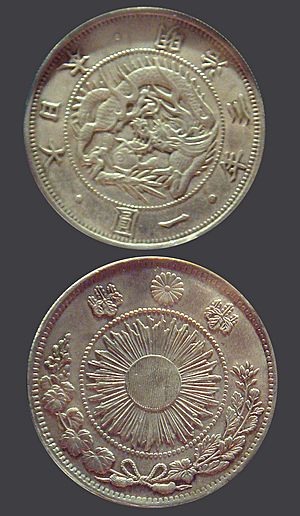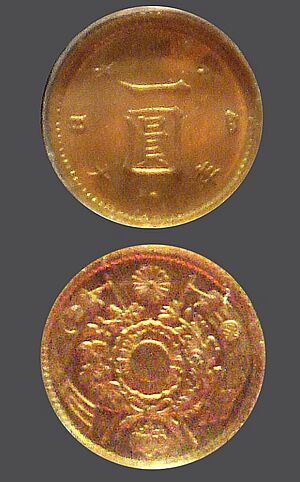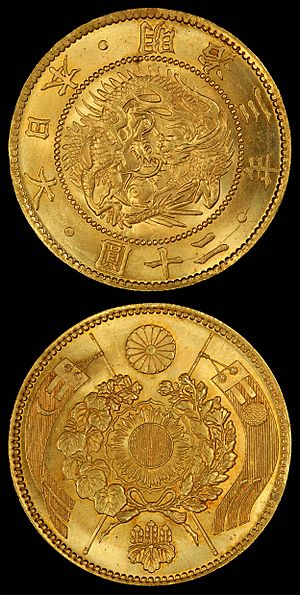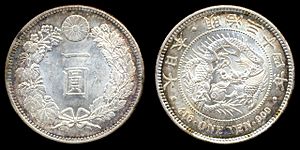Yen facts for kids
Quick facts for kids Yen |
|||||
|---|---|---|---|---|---|
|
|||||
| ISO 4217 Code | JPY | ||||
| User(s) | |||||
| Inflation | 2.6% (July 2022) | ||||
| Source | Statistics Bureau of Japan | ||||
| Symbol | ¥ | ||||
| Plural | The language(s) of this currency does not have a morphological plural distinction. | ||||
| Coins | |||||
| Freq. used | ¥1, ¥5, ¥10, ¥50, ¥100, ¥500 | ||||
| Banknotes | |||||
| Freq. used | ¥1,000, ¥5,000, ¥10,000 | ||||
| Rarely used | ¥1, ¥2, ¥5, ¥10, ¥20, ¥50, ¥100, ¥500, ¥2,000 (no longer in production; still legal tender) | ||||
| Printer | National Printing Bureau | ||||
The yen (symbol: ¥; code: JPY) is the official money of Japan. It is one of the most important currencies in the world. People use it a lot for trading and saving money. It is the third most traded currency, after the United States dollar and the euro.
Japan started using the modern yen system in 1871. This new money replaced older Japanese coins and paper money. The yen was first set to be worth a certain amount of gold or silver. The Bank of Japan was created in 1882. This bank became the only one allowed to control how much money was in Japan.
After World War II, the yen lost a lot of its value. To help Japan's economy, the yen's value was set at ¥360 for every US dollar. This was part of a global money system called the Bretton Woods system. When this system ended in 1971, the yen's value was allowed to change freely. Since then, its value has gone up and down.
Contents
What Does "Yen" Mean?
The word "yen" comes from the Japanese word "en" (円). This word means "round." It got this name because early coins were round. This is similar to how the Chinese "yuan" and Korean "won" also mean "round."
When Europeans first came to Japan, they heard the Japanese word "en" and spelled it "yen." This spelling stuck, even though the pronunciation changed over time.
History of the Yen
Japan wanted to create a modern money system like Western countries. In 1871, the Japanese government officially made the "yen" its new currency.
Early Yen Coins
Before the yen, Japan had many different kinds of money. Each local area had its own paper money. The new yen system made money the same all over Japan. This helped trade and made the country stronger. The new coins were round and made using modern machines.
The Bank of Japan was started in 1882. This bank took over from many smaller banks that used to print money. The Bank of Japan now controls all the money in the country.
Yen Coins Today
Coins were first made in 1870. They came in different values like 5, 10, 20, 50 sen (smaller units) and 1 yen in silver. There were also gold coins for 2, 5, 10, and 20 yen.
Today, Japan uses six types of coins:
- ¥1 (1 yen)
- ¥5 (5 yen)
- ¥10 (10 yen)
- ¥50 (50 yen)
- ¥100 (100 yen)
- ¥500 (500 yen)
The ¥1 coin is made of 100% aluminum. It is so light that it can float on water if you place it carefully!
The ¥500 coin is one of the highest-value coins used regularly in the world. Because it is worth so much, new versions have been made with special security features to stop people from making fake ones.
Each coin shows its value in Japanese writing. It also shows the name of Japan. The back of the coin shows the year it was made. This year is based on the reign of the current emperor, not the regular calendar year. For example:
- Coins from 1900 show "Meiji 33" (33rd year of Emperor Meiji).
- Coins from 2020 show "Reiwa 2" (2nd year of Emperor Naruhito).
| Currently circulating coins | |||||||||
|---|---|---|---|---|---|---|---|---|---|
| Image | Value | Technical parameters | Description | Date of first minting | |||||
| Diameter | Thickness | Mass | Composition | Edge | Obverse | Reverse | |||
 |
¥1 | 20 mm | 1.5 mm | 1 g | 100% aluminium | Smooth | Young tree, state title, value | Value, year of minting | 1955 |
 |
¥5 | 22 mm | 1.5 mm | 3.75 g | 60–70% copper 30–40% zinc |
Smooth | Ear of Rice, gear, water, value | State title, year of minting | 1959 |
 |
¥10 | 23.5 mm | 1.5 mm | 4.5 g | 95% copper 3–4% zinc 1–2% tin |
Reeded | Phoenix Hall, Byōdō-in, state title, value | Evergreen tree, value, year of minting | 1951 (rarely) |
| Smooth | 1959 | ||||||||
 |
¥50 | 21 mm | 1.7 mm | 4 g | Cupronickel 75% copper 25% nickel |
Reeded | Chrysanthemum, state title, value | Value, year of minting | 1967 |
 |
¥100 | 22.6 mm | 1.7 mm | 4.8 g | Cupronickel 75% copper 25% nickel |
Reeded | Cherry blossoms, state title, value | Value, year of minting | 1967 |
 |
¥500 | 26.5 mm | 1.85 mm | 7.2 g | Cupronickel 75% copper 25% nickel |
Lettered | Paulownia, state title, value | Bamboo, Mandarin orange, Value, year of minting | 1982 |
 |
¥500 | 26.5 mm | 2 mm | 7 g | (Nickel-brass) 72% copper 20% zinc 8% nickel |
Reeded slantingly | Paulownia, state title, value | Bamboo, Mandarin orange, Value, year of minting | 2000 |
 |
¥500 | 26.5 mm | 1.81 mm | 7.1 g | Bi-metallic (75% copper 12.5% zinc 12.5% nickel) |
Reeded helically | Paulownia, state title, value | Bamboo, Mandarin orange, Value, year of minting | 2021 |
| These images are to scale at 2.5 pixels per millimetre. For table standards, see the coin specification table. | |||||||||
It is easy for people who cannot see well to tell the coins apart. This is because they have different sizes, weights, and patterns on their edges.
Commemorative coins are special coins made for important events. For example, silver ¥100 and ¥1,000 coins were made for the 1964 Summer Olympics. These coins can be used like regular money, but people usually keep them.
Yen Banknotes (Paper Money)
Japan started printing yen banknotes in 1872. Today, the lowest value banknote is the ¥1,000 note. The Bank of Japan is the only place that can print yen banknotes.
Japan is a country where people often use cash. Many payments are made with physical money. This might be because people like the privacy of using cash. Also, shops get their money right away.
Japanese banknotes feature portraits of important people from Japan's modern history. Using photographs of these people helps prevent fake money from being made.
Current Banknotes (Series E)
Series E banknotes were first used in 2004. They come in ¥1,000, ¥5,000, and ¥10,000 values. These notes have special patterns to help prevent copying.
| Image | Value | Dimensions | Main Color | Description | Series | Date of issue | ||
|---|---|---|---|---|---|---|---|---|
| Obverse | Reverse | Obverse | Reverse | |||||
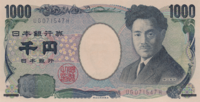 |
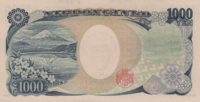 |
¥1000 | 150 × 76 mm | Blue | Hideyo Noguchi | Mount Fuji, Lake Motosu and cherry blossoms | Series E | November 1, 2004 |
 |
 |
¥2000 | 154 × 76 mm | Green | Shureimon | The Tale of Genji and portrait of Murasaki Shikibu | Series D | July 19, 2000 |
 |
 |
¥5000 | 156 × 76 mm | Purple | Ichiyō Higuchi | Kakitsubata-zu (Painting of irises, a work by Ogata Kōrin) | Series E | November 1, 2004 |
 |
 |
¥10,000 | 160 × 76 mm | Brown | Fukuzawa Yukichi | Statue of hōō (phoenix) from Byōdō-in Temple | Series E | November 1, 2004 |
New Banknotes (Series F)
New designs for the ¥1,000, ¥5,000, and ¥10,000 notes were announced in 2019. These new Series F banknotes are planned to be used starting in 2024.
- The ¥1,000 bill will show Kitasato Shibasaburō and The Great Wave off Kanagawa.
- The ¥5,000 bill will show Tsuda Umeko and Wisteria flowers.
- The ¥10,000 bill will show Shibusawa Eiichi and Tokyo Station.
The ¥2,000 note will not be redesigned because it is not used very often.
| Series F (2024, scheduled) | |||||||
|---|---|---|---|---|---|---|---|
| Image | Value | Dimensions | Main
Color |
Description | Date of issue | ||
| Obverse | Reverse | Obverse | Reverse | ||||
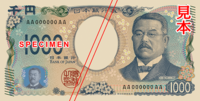 |
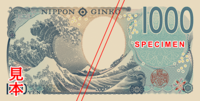 |
¥1000 | 150 × 76 mm | Blue | Kitasato Shibasaburō | The Great Wave off Kanagawa (from Thirty-six Views of Mount Fuji series by Hokusai) | 2024, scheduled |
 |
 |
¥5000 | 156 × 76 mm | Purple | Umeko Tsuda | Wisteria flowers | |
 |
 |
¥10,000 | 160 × 76 mm | Brown | Shibusawa Eiichi | Tokyo Station (Marunouchi side) | |
Why the Yen's Value Changes
The value of the yen changes in the world's money markets. This is based on how many people want to buy yen (demand) and how many people want to sell yen (supply).
Since the 1990s, the Bank of Japan has kept interest rates very low. This was done to help Japan's economy grow. Low interest rates can make the yen's value lower compared to other currencies. This is because investors might borrow yen cheaply and then invest that money in other countries where they can earn more.
Yen as a World Currency
The yen is one of the main currencies that countries keep as a "reserve currency." This means it is a safe and stable currency that central banks around the world hold. It is part of a special group of currencies used by the International Monetary Fund (IMF).
Historical Exchange Rate
Before World War II, the yen was worth about 3.6 yen to one US dollar. After the war, its value dropped a lot, sometimes as low as 600 yen per dollar. This happened because Japan printed a lot of money to pay for the war and then for rebuilding the country.
From 1949 to 1971, the yen's value was fixed at 360 yen to one US dollar. This helped Japan's economy become stable. Since 2022, the yen has become weaker compared to the US dollar. This is partly because the US has raised its interest rates, while Japan has kept its rates very low.
See also
 In Spanish: Yen para niños
In Spanish: Yen para niños
- Japan Mint
- Economy of Japan
Older Japanese Money
- Japanese mon (currency)
- Koban (coin)
- Ryō (Japanese coin)




